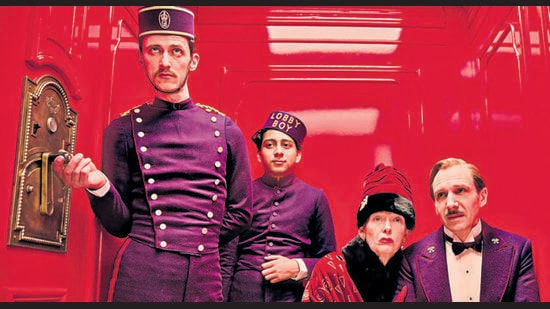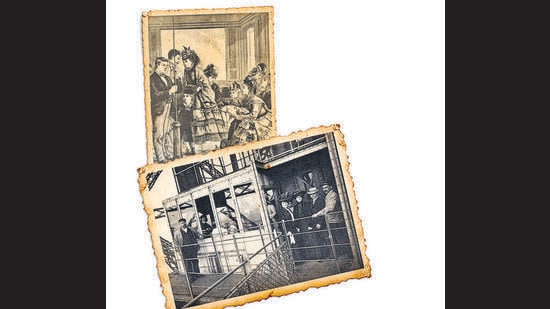At 85 sq ft, B2 is about the size of the average Mumbai living room. It has marble flooring, sparkly light fixtures and a view of the city outside. But B2 can do what a living room can’t. It can ferry its occupants up and down a five-storey building. It’s billed as the world’s largest passenger elevator. Installed at the Jio World Centre in Bandra-Kurla Complex earlier this year, it can hold 210 people. “It’s ideal for moving wedding guests, conference delegates and other large crowds at the venue,” says Amit Gossain, managing director of Kone Elevators India, which developed the lift along with Reliance Industries and Samsung.
Modern elevators have been around since the 1850s, and they seem to have had more ups than downs in their history. See how once-risky rides rose up to become record-breakers.
* We’ve been hauling ourselves, and our goods, up and down since time immemorial. How else do you think they built the Pyramids, fixed the dome on the Taj Mahal, or mined gems, metals and coal from deep inside the earth? At the Palace of Versailles, Louis XV even had a “flying chair”, a pulley-and-counterweight contraption, set up in 1743 so that his mistress could visit him in secret. Most of these lift systems were either manual or animal-driven.
* It’s one thing to raise and lower a single sitting human. It’s quite another to lift large loads. By 1765, with the invention of the steam engine, the earliest mechanical lifts were being used to reliably move construction material within taller and taller buildings in Europe.

* Humans remained unconvinced, and with good reason. The first lifts operating in England in the 1830s and in the US in the following decade relied on hemp ropes. These would fray, giving passengers a rude and sometimes fatal jolt. Wire ropes were only introduced in 1852.
* Rides got safer, but elevators were still an expensive frill. In hotels in New York, London and Paris, lavishly furnished “ascending rooms” ushered guests to their suites. American engineer Otis Tufts patented his “vertical railway” in 1859; it was a box with a bench inside. Then, in 1861, Elisha Otis, an unrelated industrialist, patented a safety brake that could keep the box suspended even if the cable snapped. Things finally got moving!
* How to make a good thing better? German inventor Werner Von Siemens developed an electric elevator in 1880. By 1887, the car doors could close automatically, making them even safer.
* As elevators became safer and faster, real-estate changed. Top-floor apartments used to fetch the lowest rents. By the end of the 19th century, penthouses, removed from the dust and smell of the streets by a swift elevator ride, were the most expensive plots in a building.
* India joined the ride in 1892, when the country’s first lift was installed at Calcutta’s Raj Bhavan. It is still in use, having been modernised in 1969 and again in 2010.
* All through the 20th century, little tweaks made rides safer. That bump that prevents doors from closing when humans are in the way was patented in 1944. Automated levelling and soft-landing drops were added in the 1960s and ’70s. In a fast-globalising world, a race began to develop faster rides, lighter cables, longer shafts and more-energy-efficient systems.

* Let’s get one record out of the way. The world’s tallest elevator isn’t in a building, it’s in a mine shaft at AngloGold Ashanti’s Mponeng gold mine in South Africa. The average elevator travels 40 ft, between four and five storeys, taking four seconds between each floor. In the mine, triple-decker steel cages drop 7,490 ft in just three minutes. Then, miners switch to a second car to drop a further 11,800 ft, and get to work. It’s a record held since 1986. Nothing from the ground up comes even close.
* On the ground, however, are other delights. In 2017, German company Thyssenkrupp began testing an elevator system that uses not ropes but magnetic levitation. The Multi, installed in a purpose-built test tower, can direct multiple cabins up and down the same electromagnetic shaft, even moving them horizontally to manage crowds, space and energy better.
* Meanwhile, the world’s tallest and fastest elevators are in one building in China. Inside the 2,074-ft Shanghai Tower, elevators designed by the Japanese Mitsubishi Electric Corporation in 2017 can climb 67 ft per second. But only if a trained technician is operating it. Most rides in the 212-storey skyscraper average 58 ft per second, to prevent passengers from becoming lightheaded on the way up or getting butterflies in the stomach on the way down.
* The Jio World Centre lift trundles, in contrast, at 3.2 ft per second. “A car that size is not built for speed but stability,” says Gossain.
* Elevators have become safer over the years. In the US, which makes data available publicly, people make 18 billion elevator trips a year. An average of 27 deaths occur annually. But of these, only five are passengers; maintenance staff make up the majority.
* The world’s second-largest elevator is in India too. It’s not far from B2. One of the freight elevators inside the Jio World Centre is only a few inches smaller. “We’re constantly asking ourselves, ‘What next?’” says Gossain. “How can we make our elevators and escalators smarter, smoother, safer and more intuitive?” The next frontier globally: AI that analyses destinations, anticipates rush hour and reads car capacities. Like Uber, but for going up and down.
Enjoy unlimited digital access with HT Premium
Subscribe Now to continue reading

Stay connected with us on social media platform for instant update click here to join our Twitter, & Facebook
We are now on Telegram. Click here to join our channel (@TechiUpdate) and stay updated with the latest Technology headlines.
For all the latest Art-Culture News Click Here

